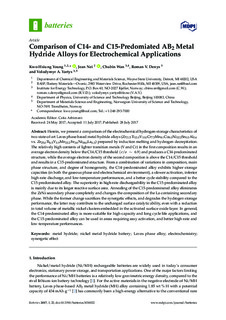| dc.contributor.author | Young, Kwo-Hsiung | |
| dc.contributor.author | Nei, Jean | |
| dc.contributor.author | Wan, Chubin | |
| dc.contributor.author | Denys, Roman Volodymyrovich | |
| dc.contributor.author | Yartys, Volodymyr | |
| dc.date.accessioned | 2017-10-16T12:35:36Z | |
| dc.date.available | 2017-10-16T12:35:36Z | |
| dc.date.created | 2017-10-12T12:14:15Z | |
| dc.date.issued | 2017 | |
| dc.identifier.issn | 2313-0105 | |
| dc.identifier.uri | http://hdl.handle.net/11250/2460328 | |
| dc.description.abstract | Herein, we present a comparison of the electrochemical hydrogen-storage characteristics of two state-of-art Laves phase-based metal hydride alloys (Zr21.5Ti12.0V10.0Cr7.5Mn8.1Co8.0Ni32.2Sn0.3Al0.4 vs. Zr25.0Ti6.5V3.9Mn22.2Fe3.8Ni38.0La0.3) prepared by induction melting and hydrogen decrepitation. The relatively high contents of lighter transition metals (V and Cr) in the first composition results in an average electron density below the C14/C15 threshold (e/a~6.9) and produces a C14-predominated structure, while the average electron density of the second composition is above the C14/C15 threshold and results in a C15-predominated structure. From a combination of variations in composition, main phase structure, and degree of homogeneity, the C14-predominated alloy exhibits higher storage capacities (in both the gaseous phase and electrochemical environment), a slower activation, inferior high-rate discharge, and low-temperature performances, and a better cycle stability compared to the C15-predominated alloy. The superiority in high-rate dischargeability in the C15-predominated alloy is mainly due to its larger reactive surface area. Annealing of the C15-predominated alloy eliminates the ZrNi secondary phase completely and changes the composition of the La-containing secondary phase. While the former change sacrifices the synergetic effects, and degrades the hydrogen storage performance, the latter may contribute to the unchanged surface catalytic ability, even with a reduction in total volume of metallic nickel clusters embedded in the activated surface oxide layer. In general, the C14-predominated alloy is more suitable for high-capacity and long cycle life applications, and the C15-predominated alloy can be used in areas requiring easy activation, and better high-rate and low-temperature performances. | nb_NO |
| dc.language.iso | eng | nb_NO |
| dc.publisher | MDPI | nb_NO |
| dc.rights | Navngivelse 4.0 Internasjonal | * |
| dc.rights.uri | http://creativecommons.org/licenses/by/4.0/deed.no | * |
| dc.title | Comparison of C14- and C15-Predomiated AB2 Metal Hydride Alloys for Electrochemical Applications | nb_NO |
| dc.type | Journal article | nb_NO |
| dc.description.version | publishedVersion | nb_NO |
| dc.source.volume | 3 | nb_NO |
| dc.source.journal | Batteries | nb_NO |
| dc.source.issue | 3 | nb_NO |
| dc.identifier.doi | 10.3390/batteries3030022 | |
| dc.identifier.cristin | 1504109 | |
| dc.relation.project | Norges forskningsråd: 257653 | nb_NO |
| dc.description.localcode | © 2017 The Authors. This is an open access article distributed under the Creative Commons Attribution License which permits unrestricted use, distribution, and reproduction in any medium, provided the original work is properly cited. (CC BY 4.0). | nb_NO |
| cristin.unitcode | 194,66,35,0 | |
| cristin.unitname | Institutt for materialteknologi | |
| cristin.ispublished | true | |
| cristin.fulltext | original | |

